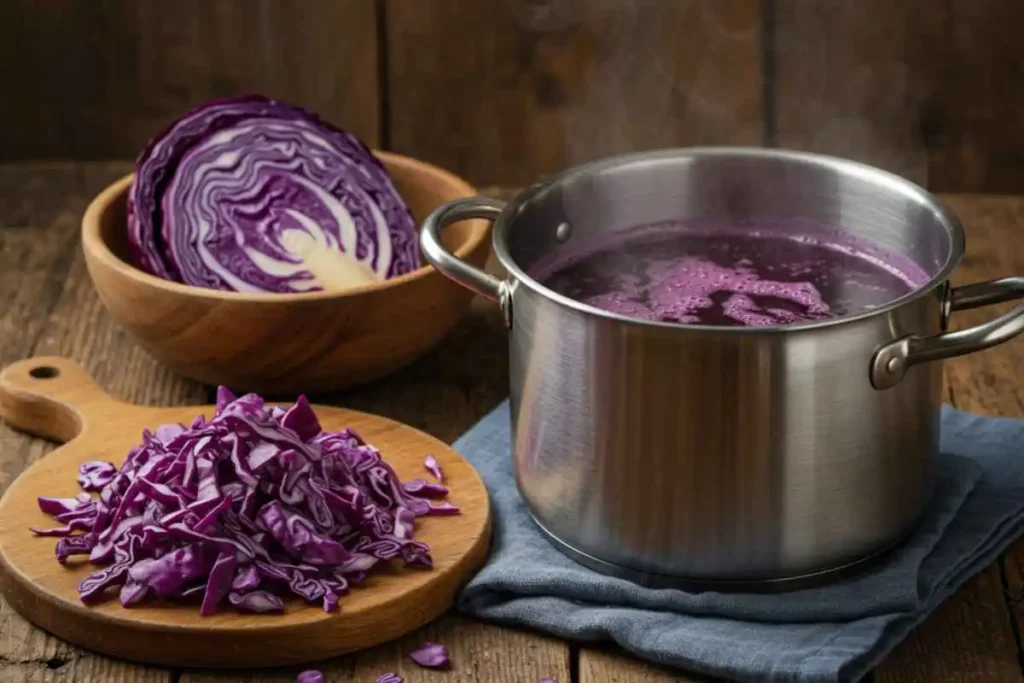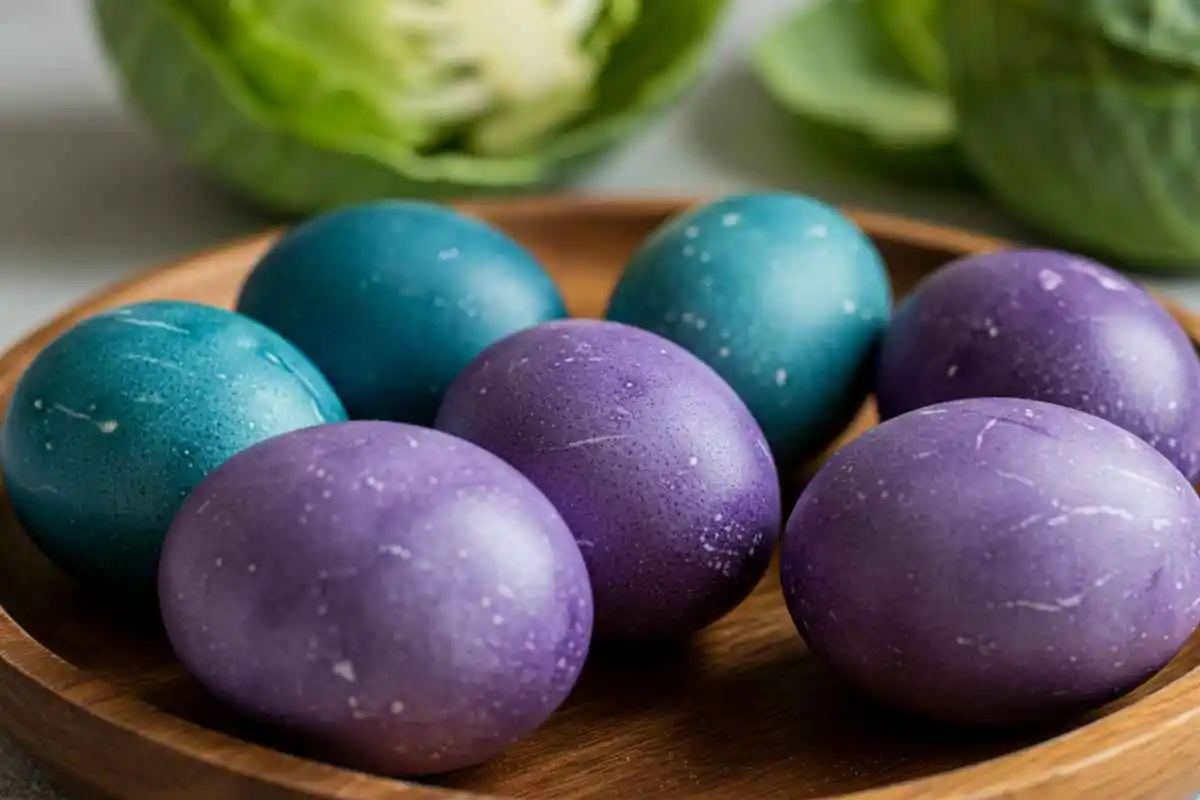Introduction
Coloring eggs with natural dyes is a fun and eco-friendly way to celebrate holidays and special occasions. If you’re wondering how to color eggs with cabbage, this guide will walk you through the entire process, from preparing the dye to achieving stunning blue and purple hues. Using red cabbage as a natural dye is not only a chemical-free alternative to synthetic food dyes, but it also creates unique, vibrant shades based on simple pH adjustments. Whether you’re looking for a safe dyeing method for kids or want to try a sustainable Easter egg craft, this step-by-step tutorial has you covered
History of Egg Dyeing
Origins of Egg Dyeing Traditions
Egg dyeing dates back thousands of years, with evidence suggesting it was practiced in ancient civilizations such as Persia and Egypt. In many cultures, eggs symbolize fertility, rebirth, and renewal, making them a perfect representation for spring celebrations.
Cultural Significance Across the World
- Christianity: Easter egg dyeing symbolizes the resurrection of Jesus.
- Persian New Year (Nowruz): Decorated eggs mark the arrival of spring.
- Ukrainian Pysanky: Intricate egg designs are an ancient art form passed down generations.
Benefits of Natural Dyeing Methods
Health and Safety Considerations
Artificial food dyes often contain chemicals that may not be safe for consumption, especially for children. Natural dyes, such as those from cabbage, are non-toxic and edible.
Environmental Advantages
Using natural dyes reduces chemical waste and pollution, making it a more sustainable practice.
Aesthetic Appeal
Natural dyes create unique, earthy, and organic tones that can’t be replicated with synthetic colors.
Understanding Natural Dyes
What Are Natural Dyes?
Natural dyes are pigments derived from plants, fruits, and minerals, often used for fabric dyeing, food coloring, and Easter eggs.
How Natural Dyes Work
When boiled, plant materials release pigments that bind to porous surfaces like eggshells, creating unique colors.
Common Sources of Natural Dyes
- Red cabbage → Blue/purple tones
- Turmeric → Yellow
- Beets → Pink/red
- Onion skins → Orange/brown
- Spinach → Green
Why Use Cabbage for Egg Dyeing?
Chemical Properties of Cabbage
Red cabbage contains anthocyanins, natural pigments that change color based on pH levels.
Color Outcomes with Cabbage Dye
- Blue eggs (with vinegar)
- Purple eggs (with alkaline solutions like baking soda)
Comparison with Other Natural Dyes
Unlike other plant-based dyes, cabbage produces cool-toned colors, making it a unique choice for egg dyeing .
Types of Cabbage Suitable for Dyeing
Red Cabbage
- The best option for creating blue and purple hues on eggs.
Green Cabbage
- Does not work well as a dyeing agent due to its low pigment content.
Preparing the Cabbage Dye
Selecting Fresh Cabbage
Choose firm, vibrant red cabbage for the richest color.

Chopping and Boiling Process
- Chop 1 head of red cabbage into small pieces.
- Place in a large pot and add 4 cups of water.
- Simmer for 30-45 minutes until the water turns deep purple.
Straining and Storing the Dye
- Strain the liquid into a glass jar and let it cool before using.
Materials Needed for Dyeing Eggs with Cabbage
Essential Materials
- Red cabbage
- White eggs
- Vinegar
- Water
- Saucepan
- Strainer
- Glass jars
- Spoon
Alternative Tools and Substitutions
- Brown eggs → Produce different tones
- Baking soda → Adjusts pH for varied colors
Step-by-Step Guide to Dyeing Eggs with Cabbage
Preparing the Eggs
- Hard-boil eggs and let them cool.
- Clean them with vinegar to remove oil.
Immersion Techniques
- Submerge eggs in cooled cabbage dye.
- Add 1 tablespoon of vinegar to enhance the blue color.
Duration and Intensity of Dyeing
- 1 hour → Light blue
- Overnight → Deep blue
Achieving Different Shades and Patterns
Factors Affecting Color Intensity
- Vinegar makes the color brighter.
- Soaking longer deepens the shade.

Creating Patterns and Designs
- Rubber bands → Stripe patterns
- Cracked shells → Marble effect
Troubleshooting Common Issues
- Dull colors? Add more vinegar.
- Uneven dyeing? Stir occasionally.
Safety Precautions and Tips
Handling Hot Liquids
Always let the dye cool before handling.
Preventing Stains
Wear gloves to avoid blue-stained hands.
Safe Storage of Dyed Eggs
Keep dyed eggs in the refrigerator for up to one week.
Alternative Natural Dye Sources
Other Vegetables and Fruits
- Beets → Pink
- Onion Skins → Orange
Spices and Teas
- Turmeric → Yellow
- Hibiscus Tea → Red
Combining Dyes for Varied Colors
Mixing cabbage dye with turmeric can create green shades.
Creative Uses for Cabbage-Dyed Eggs
Decorative Purposes
Use naturally dyed eggs for table centerpieces.
Culinary Uses
Enjoy these eggs in salads or as snacks.
Gifting Ideas
Wrap dyed eggs in eco-friendly packaging for gifts.
Frequently Asked Questions (FAQs)
How do you dye eggs with cabbage?
Chop red cabbage, boil it in water, strain the dye, and soak eggs in it for a few hours.
Does purple cabbage make eggs blue?
Yes! When combined with vinegar, red cabbage creates a beautiful blue shade on eggs.
What color would your egg turn out if you dyed it using red cabbage?
Depending on pH and soaking time:
- With vinegar → Blue
- With baking soda → Purple
How to dye things with cabbage?
The same method can be used for fabrics, paper, and even hair.
Advanced Techniques for Natural Egg Dyeing
If you’ve already learned how to color eggs with cabbage, it’s time to take your creativity to the next level. These advanced methods allow you to craft beautifully detailed eggs using nothing more than natural ingredients.
Layered Color Effects
One of the most exciting aspects of mastering how to color eggs with cabbage is the ability to create layered color effects. Here’s how:
- First Dip – Soak the egg in cabbage dye for a few minutes for a soft, light blue hue.
- Second Dip – Let the egg dry completely, then repeat the process to deepen the color.
- Third Dip with a Twist – After learning how to color eggs with cabbage, try adding turmeric dye on top of the blue base. This creates stunning green tones through natural blending.
Wax-Resist (Batik) Method
For those already skilled in how to color eggs with cabbage, the batik method adds intricate detail to your designs:
- Melt beeswax and draw patterns on the eggshell.
- Dye the egg using your cabbage solution.
- Once dry, gently scrape off the wax to reveal white designs over the colored surface.
This technique, common in Ukrainian Pysanky, works beautifully with cabbage dye.
Marbleized and Speckled Effects
Another fun extension of how to color eggs with cabbage involves marbleized textures:
- Add a teaspoon of oil to the cabbage dye. The oil repels some dye, creating a swirling, stone-like effect.
- For speckles, sprinkle vinegar onto the shell before dyeing. This results in intense, mottled patterns after the color sets.
How to Make the Dye Last Longer
When practicing how to color eggs with cabbage, preserving your dye and the finished product is essential.
Storing the Dye Properly:
- Refrigerate the leftover dye in a sealed glass jar for up to a week.
- Freeze it in ice cube trays for easy future use.
Extending Color Fastness on Eggs:
- Soak eggs in vinegar beforehand to help absorb the cabbage dye better.
- Once dry, rub eggs with coconut or olive oil to enhance their shine and make colors last longer.
Eco-Friendly Disposal of Leftover Dye
Once you’ve enjoyed experimenting with how to color eggs with cabbage, dispose of your materials in an eco-friendly way:
- Compost the boiled cabbage used for dyeing.
- Repurpose the dye for natural fabric coloring or as eco-friendly watercolor paint for kids’ crafts.
Comparing Natural and Synthetic Dyes
Health Impact
| Feature | Natural Dyes (Cabbage) | Synthetic Dyes |
|---|---|---|
| Toxicity | Non-toxic, safe for kids | May contain artificial chemicals |
| Allergy Risk | Low | Can trigger skin irritations |
| Safe to Eat? | Yes | Some may not be food-safe |
Environmental Impact
| Feature | Natural Dyes (Cabbage) | Synthetic Dyes |
|---|---|---|
| Biodegradable? | Yes | No |
| Eco-Friendly? | Yes | No |
Common Mistakes and How to Avoid Them
Even though dyeing eggs with cabbage is simple, a few mistakes can affect the outcome.
Eggs Not Turning Blue?
- Possible Cause: Not adding vinegar.
- Solution: Ensure at least 1 tablespoon of vinegar is added to the dye.
Uneven Coloring?
- Possible Cause: Egg was not cleaned properly.
- Solution: Wipe eggs with vinegar before dyeing to remove any oil residue.
Dye Fading Too Fast?
- Possible Cause: Exposure to heat and sunlight.
- Solution: Keep dyed eggs refrigerated until use.
Fun Facts About Cabbage Dye
- Ancient Origins – The use of cabbage as a dye dates back to early civilizations.
- Magic pH Effect – Red cabbage dye is an excellent pH indicator; it turns red in acidic solutions and blue-green in alkaline solutions.
- Dye Intensity Increases Over Time – Unlike synthetic dyes that set immediately, cabbage dye gets darker the longer you leave it.
Alternative Ways to Enhance Cabbage Dyeing
While the basic cabbage dyeing process is effective, you can modify the technique for more vibrant or varied results.
Adding Natural Mordants for Brighter Colors
Mordants are substances that help set dyes and enhance color intensity. Common natural mordants include:
- Alum (Potassium Aluminum Sulfate) – Intensifies the blue color.
- Cream of Tartar – Helps the dye bond better to eggshells.
- Iron (Rusty Nails or Steel Wool in Vinegar) – Can darken colors for a deeper blue-gray tone.
How to Use Mordants for Egg Dyeing
- Dissolve a small amount (1 tsp) of mordant in warm water.
- Soak eggs in the mordant solution before dipping them into the cabbage dye.
- Let the eggs dry naturally for a richer color.
Experimenting with Different Vinegar Concentrations
Vinegar is a crucial ingredient that affects dye absorption. However, you can adjust it to manipulate color results:
- 1 tsp vinegar – Light pastel blue
- 1 tbsp vinegar – Bright sky blue
- 2+ tbsp vinegar – Intense deep blue
Multi-Color Egg Dyeing Using Cabbage and Other Natural Dyes
To create multi-colored eggs, you can use layering techniques with different natural dyes.
Combining Cabbage with Other Natural Dyes
- Cabbage + Turmeric → Greenish-blue tones
- Cabbage + Beet Juice → Soft lavender
- Cabbage + Red Onion Skins → Deep purple

Step-by-Step Guide for Layered Coloring
- Start with the lightest dye (e.g., turmeric for yellow).
- Let the egg dry completely.
- Dip it into the cabbage dye for a layered effect.
- Repeat for more complex color variations.
Natural Egg Dyeing for Special Occasions
Beyond Easter, you can use cabbage-dyed eggs for other cultural and personal celebrations.
Spring Celebrations and Rituals
Many ancient pagan traditions involved coloring eggs to celebrate spring equinox festivals, symbolizing renewal and fertility.
Wedding and Baby Shower Decor
- Cabbage-dyed eggs in soft blues and lavenders make elegant, eco-friendly decorations for weddings, gender reveals, and baby showers.
- Pair them with white flowers and rustic baskets for a natural aesthetic.
Holiday and Themed Decorations
- Christmas: Use blue eggs with gold leaf for a wintery look.
- Halloween: Pair dark blue eggs with orange for spooky vibes.
Preserving and Displaying Dyed Eggs
How to Make Your Dyed Eggs Last Longer
If you want to preserve dyed eggs as keepsakes, follow these methods:
- Blow Out the Egg Yolk – Use a needle to make small holes, then blow out the yolk before dyeing.
- Coat with Clear Sealant – Spray eggs with a natural sealant to prevent fading.

Creating a Decorative Egg Display
- Arrange cabbage-dyed eggs in moss-lined baskets for a rustic touch.
- Use an egg stand or wooden holders for a minimalist, modern display.
Teaching Kids the Science Behind Cabbage Dyeing
This is a great educational activity for kids, teaching them color theory, chemistry, and sustainability.
Explaining the pH Color Change
- Acidic (Vinegar) → Blue
- Neutral → Purple
- Alkaline (Baking Soda) → Green
Simple Science Experiments for Kids
- Have kids test different household liquids (lemon juice, baking soda water) to see how the cabbage dye changes color.
- Ask them to guess the color outcome before dipping the eggs.
Fun DIY Craft Ideas Using Cabbage-Dyed Eggs
Once your eggs are dyed, here are some creative ways to use them:
Turning Dyed Eggs into Home Decor
- Make a Nature-Inspired Centerpiece – Arrange eggs in a wooden bowl with dried flowers.
- Egg Garland – Hollow out dyed eggs and string them as wall decor.
Creating Easter-Themed Gifts
- Personalized Messages – Write names or quotes on the eggs with gold marker.
- Egg Surprise Box – Fill blown-out eggs with small notes or candies.
Frequently Asked Questions (Additional FAQs)
Can I Dye Brown Eggs with Cabbage?
Yes! However, brown eggs result in darker, muted tones rather than bright blue shades.
Can I Eat Cabbage-Dyed Eggs?
Absolutely! The dyeing process is completely food-safe, but they should be stored in the refrigerator and eaten within one week.
Why Do My Eggs Look Splotchy?
Uneven dyeing happens when the egg isn’t clean. Wipe eggs with vinegar before dyeing for a smoother result.
Can I Mix Cabbage Dye with Other Natural Dyes?
Yes! Mixing dyes creates new shades:
- Cabbage + Turmeric = Green
- Cabbage + Coffee = Deep Teal
Final Thoughts – Why You Should Try Cabbage Egg Dyeing
Dyeing eggs with cabbage is an eco-friendly, chemical-free, and fun way to create beautiful, natural-colored eggs. Unlike synthetic dyes, cabbage provides a unique color-changing experience, allowing you to experiment with shades, patterns, and designs.
Whether you’re celebrating a holiday, teaching kids about natural dyes, or simply trying something new, this ancient yet modern technique is a rewarding craft for all ages.
More Delicious Recipes
- How to Make Rice Paper Not Soggy: Expert Tips & Best Techniques
What is a Typical Lebanese Breakfast? A Delicious Taste of Tradition
Is Chicken Breakfast Sausage Healthy? The Truth You Need to Know

